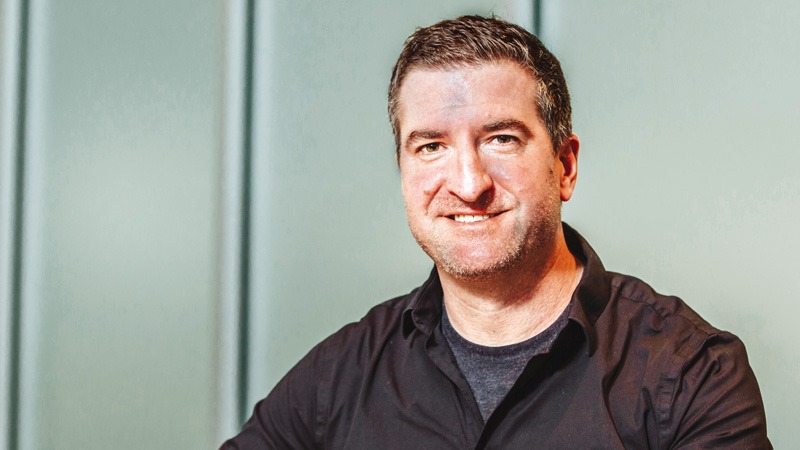A Q+A With Brian Revoir, Senior Designer at Landscape Forms.
WHAT IS YOUR ROLE AT LANDSCAPE FORMS?
At Landscape Forms, we create outdoor furnishings and site amenities, lighting, and custom work. I’m part of a three-person design team, so the projects get split up between us. We’re authors in a sense. Working on a tight-knit team is fun because we’re constantly switching it up. If you know what you’re looking for, you’ll see our work everywhere. We’re up in Grand Rapids, we’re in New York City, and if you’re sitting on a bench on the Kalamazoo Mall, there is a good likelihood we designed it.
WHY IS DESIGNING INTENTIONAL OUTDOOR SPACES SO IMPORTANT?
We are passionate about the outdoors—it’s the center of our universe. For our team, our role is not just about designing and building furniture; we also educate people about the value of outdoor space. For example, if you travel to Fiji, you won’t spend your time there taking photos in the hotel lobby. You’ll be too excited to get outside and enjoy the sun.
WHAT IS GOOD DESIGN?
Good design is timeless. It’s why we fall in love with things. Designers don’t just restyle; in my role as an industrial designer, my job is not only to make something beautiful but to solve a problem. Some of the best projects I’ve worked on have provided solutions that people didn’t even know they needed. If you can do that, the design will speak to everyone. One of the joys of working as an industrial designer is when you have a moment of clarity and finally find a solution. I love those “ah-ha” moments.
WHERE DO YOU GET IDEAS FOR NEW PRODUCTS?
My ideas are insight-driven. To design a new product, we do a lot of human observation to learn how people operate in a particular space. My team will stake out an area and observe people going to get a beer together or hurrying to work. If you watch carefully, you’ll see that people don’t stop in big, wide-open spaces. Nobody sits down in the middle of a field; they’ll pick a tree instead—it’s subconscious. We try to design functional social anchor points—like a kiosk or a shaded picnic table—in an outdoor space that serve the same purpose and give people something to gravitate towards.
WHAT OTHER INSIGHTS HAVE YOU GAINED THROUGH OBSERVATION?
Large groups of people behave very much like a river in the sense that water flows quickly down the center but slows down and spins in eddies along the edges. If you look at people, they also pull away from the middle and stop by social anchor points, allowing others to move past. When we’re designing space and want a stream of people to slow down and utilize an area, we can create a pinch point in the middle that causes people to slow down and flow around it. Think about it like tossing a boulder in the middle of a river. A great example of this is The Bean (Cloud Gate) in Chicago’s Millennium Park; it’s designed so people can zip around it, but it also serves as an attraction point for people to gather [around].
WHEN DID YOU KNOW THAT YOU WANTED TO PURSUE DESIGN?
I grew up in a very creative household. My brother and I drew constantly. As I got older, I got into other outlets. I built a lot of models—and not the plastic kind you buy in the store. I’d cut up balsa wood and build models from scratch. I knew I wanted to do something creative as a professional, but I didn’t know what that meant. I knew it would be really difficult to find someone who would pay me to draw dragons all day. But luckily I made it work.
HOW DID YOU DECIDE ON A CAREER IN INDUSTRIAL DESIGN?
I went to RIT (Rochester Institute of Technology) in New York. My first year was filled with a broad range of art courses. I was taking drawing and ceramics classes to find out which path I wanted to take. Then I walked into the industrial design department. I remember seeing market renderings like you see in old ads for cars or power tools. I instantly gravitated towards the department because not only was I able to draw, but my drawings had the potential to become real.
WHAT ADVICE WOULD YOU GIVE TO ASPIRING DESIGNERS?
I think the more you immerse yourself in creativity—whether it’s building models, painting, taking some art classes, or tinkering—the more you will discover where your compass is pointing. If you’re in high school and discover you have a creative streak, I would ramp that up and build a portfolio. My college selected me because of the work I was able to do in my high school classes. My grades were secondary. Design schools aren’t necessarily looking for a Rembrandt, but they do want to know that you are a diversified thinker, creative, and hungry to learn.

